| کد مقاله | کد نشریه | سال انتشار | مقاله انگلیسی | نسخه تمام متن |
|---|---|---|---|---|
| 5627915 | 1406358 | 2017 | 10 صفحه PDF | دانلود رایگان |
- Old individuals showed greater muscle activation with no changes in firing rates.
- Old individuals showed lower twitch force potentiation and longer twitch contraction duration.
- Altered muscle quality likely contributed to age-related changes in twitch contractile properties.
ObjectiveTo examine twitch force potentiation and twitch contraction duration, as well as electromyographic amplitude (EMGRMS) and motor unit mean firing rates (MFR) at targeted forces between young and old individuals in the first dorsal interosseous (FDI). Ultrasonography was used to assess muscle quality.MethodsTwenty-two young (YG) (age = 22.6 ± 2.7 years) and 14 older (OD) (age = 62.1 ± 4.7 years) individuals completed conditioning contractions at 10% and 50% maximal voluntary contraction, (MVC) during which EMGRMS and MFRs were assessed. Evoked twitches preceded and followed the conditioning contractions. Ultrasound images were taken to quantify muscle quality (cross-sectional area [CSA] and echo intensity [EI]).ResultsNo differences were found between young and old for CSA, pre-conditioning contraction twitch force, or MFRs (P > 0.05). However, OD individuals exhibited greater EI and contraction duration (P < 0.05), and EMGRMS (YG = 35.4 ± 8.7%, OD = 43.4 ± 13.2%; P = 0.034). Twitch force potentiation was lower for OD (0.311 ± 0.15 N) than YG (0.619 ± 0.26 N) from pre- to post-50% conditioning contraction (P < 0.001).ConclusionsLower levels of potentiation with elongated contraction durations likely contributed to greater muscle activation during the conditioning contractions in the OD rather than altered MFRs. Ultrasonography suggested age-related changes in muscle structure contributed to altered contractile properties in the OD.SignificanceGreater muscle activation requirements can have negative implications on fatigue resistance at low to moderate intensities in older individuals.
Journal: Clinical Neurophysiology - Volume 128, Issue 6, June 2017, Pages 925-934
